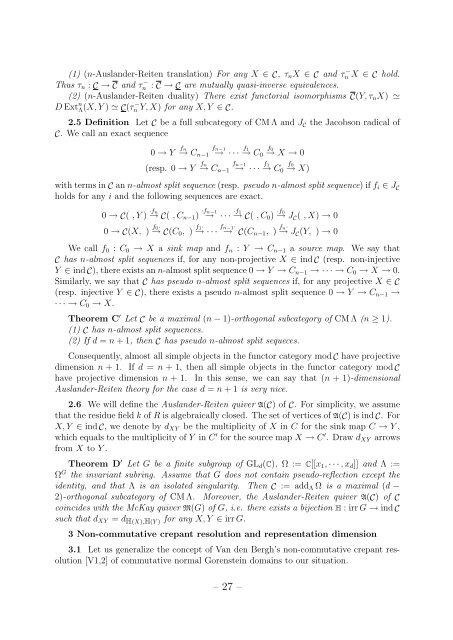HIGHER DIMENSIONAL AUSLANDER-REITEN THEORY ON ...
HIGHER DIMENSIONAL AUSLANDER-REITEN THEORY ON ...
HIGHER DIMENSIONAL AUSLANDER-REITEN THEORY ON ...
Create successful ePaper yourself
Turn your PDF publications into a flip-book with our unique Google optimized e-Paper software.
(1) (n-Auslander-Reiten translation) For any X ∈ C, τ n X ∈ C and τn − X ∈ C hold.<br />
Thus τ n : C → C and τn<br />
− : C → C are mutually quasi-inverse equivalences.<br />
(2) (n-Auslander-Reiten duality) There exist functorial isomorphisms C(Y, τ n X) ≃<br />
D Ext n Λ(X, Y ) ≃ C(τn − Y, X) for any X, Y ∈ C.<br />
2.5 Definition Let C be a full subcategory of CM Λ and J C the Jacobson radical of<br />
C. We call an exact sequence<br />
0 → Y → fn f n−1 f<br />
C n−1 → · · · 1→ f<br />
C0<br />
0→<br />
X → 0<br />
(resp. 0 → Y → fn f n−1 f<br />
C n−1 → · · · 1→ f<br />
C0<br />
0→<br />
X)<br />
with terms in C an n-almost split sequence (resp. pseudo n-almost split sequence) if f i ∈ J C<br />
holds for any i and the following sequences are exact.<br />
0 → C( , Y ) → ·fn<br />
C( , C n−1 ) ·f n−1<br />
→ · · · ·f 1<br />
→ C( , C 0 ) ·f 0<br />
→ J C ( , X) → 0<br />
0 → C(X, ) f 0·<br />
→ C(C 0 , ) f 1·<br />
→ · · · fn−1·<br />
→ C(C n−1 , ) fn·<br />
→ J C (Y, ) → 0<br />
We call f 0 : C 0 → X a sink map and f n : Y → C n−1 a source map. We say that<br />
C has n-almost split sequences if, for any non-projective X ∈ ind C (resp. non-injective<br />
Y ∈ ind C), there exists an n-almost split sequence 0 → Y → C n−1 → · · · → C 0 → X → 0.<br />
Similarly, we say that C has pseudo n-almost split sequences if, for any projective X ∈ C<br />
(resp. injective Y ∈ C), there exists a pseudo n-almost split sequence 0 → Y → C n−1 →<br />
· · · → C 0 → X.<br />
Theorem C ′ Let C be a maximal (n − 1)-orthogonal subcategory of CM Λ (n ≥ 1).<br />
(1) C has n-almost split sequences.<br />
(2) If d = n + 1, then C has pseudo n-almost split sequeces.<br />
Consequently, almost all simple objects in the functor category mod C have projective<br />
dimension n + 1. If d = n + 1, then all simple objects in the functor category mod C<br />
have projective dimension n + 1. In this sense, we can say that (n + 1)-dimensional<br />
Auslander-Reiten theory for the case d = n + 1 is very nice.<br />
2.6 We will define the Auslander-Reiten quiver A(C) of C. For simplicity, we assume<br />
that the residue field k of R is algebraically closed. The set of vertices of A(C) is ind C. For<br />
X, Y ∈ ind C, we denote by d XY be the multiplicity of X in C for the sink map C → Y ,<br />
which equals to the multiplicity of Y in C ′ for the source map X → C ′ . Draw d XY arrows<br />
from X to Y .<br />
Theorem D ′ Let G be a finite subgroup of GL d (C), Ω := C[[x 1 , · · · , x d ]] and Λ :=<br />
Ω G the invariant subring. Assume that G does not contain pseudo-reflection except the<br />
identity, and that Λ is an isolated singularity. Then C := add Λ Ω is a maximal (d −<br />
2)-orthogonal subcategory of CM Λ. Moreover, the Auslander-Reiten quiver A(C) of C<br />
coincides with the McKay quiver M(G) of G, i.e. there exists a bijection H : irr G → ind C<br />
such that d XY = d H(X),H(Y ) for any X, Y ∈ irr G.<br />
3 Non-commutative crepant resolution and representation dimension<br />
3.1 Let us generalize the concept of Van den Bergh’s non-commutative crepant resolution<br />
[V1,2] of commutative normal Gorenstein domains to our situation.<br />
– 27 –















